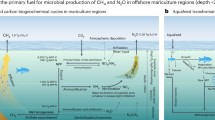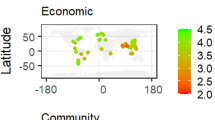Abstract
Aquaculture carrying capacity (CC) can be used to guide sustainable aquaculture development over the long term through the regenerative power of the environment. In this study, a model has been developed to estimate CC by combining marine spatial planning for physical CC, management criteria for production CC, eutrophication and pathogen risk for ecological CC, and social acceptance based on legislative and management criteria. The estimates of CC for major African freshwater lakes and the marine exclusive economic zones of Africa indicate that 10–11 Mt of fish could be produced annually while preserving ecosystem goods and services, potentially increasing fish consumption by the population of the African continent by 7 kg per capita per year (an increase of 70%). Supply-side forecasts and demand-side estimates can support policymakers in defining targets for aquaculture expansion that avoid ecological, economic and social tipping points.
This is a preview of subscription content, access via your institution
Access options
Access Nature and 54 other Nature Portfolio journals
Get Nature+, our best-value online-access subscription
$32.99 / 30 days
cancel any time
Subscribe to this journal
Receive 12 digital issues and online access to articles
$119.00 per year
only $9.92 per issue
Buy this article
- Purchase on SpringerLink
- Instant access to full article PDF
Prices may be subject to local taxes which are calculated during checkout




Similar content being viewed by others
Data availability
All data used for the carrying capacity calculations are provided in the Supplementary Information and the spreadsheet model available at https://gitlab.com/nature-food/aqrate-calculation/-/blob/b77243d83cee8c8841b01865e439c2541736e499/AQRATE_calculation_template.xlsx.
Code availability
The equations used to determine carrying capacity can be implemented in simple spreadsheets, making the approach a good alternative to the development of complex computer code. A full spreadsheet model illustrating the application of AQRATE to one of the case studies is available at https://gitlab.com/nature-food/aqrate-calculation/-/blob/b77243d83cee8c8841b01865e439c2541736e499/AQRATE_calculation_template.xlsx.
References
The State of World Fisheries and Aquaculture (FAO, 2022).
Costello, C. et al. The future of food from the sea. Nature 588, 95–100 (2020).
Inglis, G. J., Hayden, B. J. & Ross, A. H. An Overview of Factors Affecting the Carrying Capacity of Coastal Embayments for Mussel Culture Client Report CHC00/69 (NIWA, 2000).
Sanchez-Jerez, P. et al. Aquaculture’s struggle for space: the need for coastal planning and the potential benefits of Allocated Zones for Aquaculture (AZAs) to avoid conflict and promote sustainability. Aquac. Environ. Interact. 8, 41–54 (2016).
Ferreira, J., Ramos, L. & Costa-Pierce, B. A. Key drivers and issues surrounding carrying capacity and site selection, with emphasis on environmental components. In FAO Fisheries and Aquaculture Proceedings No. 21 (eds Ross, L. G. et al.) 47–86 (FAO, 2013).
Soto, D. et al. Applying an ecosystem-based approach to aquaculture: principles, scales and some management measures. In FAO Fisheries and Aquaculture Proceedings No. 14 (eds Soto, D. et al.) 15–36 (FAO, 2008).
Falconer, L., Telfer, T. C. & Ross, L. G. Investigation of a novel approach for aquaculture site selection. J. Environ. Manage. 181, 791–804 (2016).
Aura, C. M. et al. A GIS-based approach for delineating suitable areas for cage fish culture in a lake. Lakes Reserv. 26, e12357 (2021).
Gangnery, A. et al. Growth model of the Pacific oyster, Crassostrea gigas, cultured in Thau Lagoon (Méditerranée, France). Aquaculture 215, 267–290 (2003).
McKindsey, C. W., Thetmeyer, H., Landry, T. & Silvert, W. Review of recent carrying capacity models for bivalve culture and recommendations for research and management. Aquaculture 261, 451–462 (2006).
Brigolin, D., Maschio, G. D., Rampazzo, F., Giani, M. & Pastres, R. An individual-based population dynamic model for estimating biomass yield and nutrient fluxes through an off-shore mussel (Mytilus galloprovincialis) farm. Estuar. Coast. Shelf Sci. 82, 365–376 (2009).
Nobre, A. M. et al. Assessment of coastal management options by means of multilayered ecosystem models. Estuar. Coast. Shelf Sci. 87, 43–62 (2010).
Ferreira, J. G. et al. From soil to sea: an ecological modelling framework for sustainable aquaculture. Aquaculture 577, 739920 (2023).
Filgueira, R., Guyondet, T., Comeau, L. A. & Grant, J. A fully-spatial ecosystem-DEB model of oyster (Crassostrea virginica) carrying capacity in the Richibucto Estuary, Eastern Canada. J. Mar. Syst. 136, 42–54 (2014).
Ferreira, J. G. et al. Ecological carrying capacity for shellfish aquaculture—sustainability of naturally occurring filter-feeders and cultivated bivalves. J. Shellfish Res. 37, 709–726 (2018).
Føre, M. et al. Modelling growth performance and feeding behaviour of Atlantic salmon (Salmo salar L.) in commercial-size aquaculture net pens: model details and validation through full-scale experiments. Aquaculture 464, 268–278 (2016).
Stavrakidis-Zachou, O., Papandroulakis, N. & Lika, K. A DEB model for European sea bass (Dicentrarchus labrax): parameterisation and application in aquaculture. J. Sea Res. 143, 262–271 (2019).
Cubillo, A. M. et al. Role of deposit feeders in integrated multi-trophic aquaculture—a model analysis. Aquaculture 453, 54–66 (2016).
Cromey, C. J., Nickell, T. D. & Black, K. D. DEPOMOD—modelling the deposition and biological effects of waste solids from marine cage farms. Aquaculture 214, 211–239 (2002).
Hargrave, B. T. Empirical relationships describing benthic impacts of salmon aquaculture. Aquac. Environ. Interact. 1, 33–46 (2010).
Bidegain, E. N. et al. Modeling the transmission of Perkinsus marinus in the Eastern oyster Crassostrea virginica. Fish. Res. 186, 82–93 (2017).
Alaliyat, S., Yndestad, H. & Davidsen, P. I. An agent-based approach for predicting patterns of pathogen transmission between aquaculture sites in the Norwegian fjords. Aquaculture 505, 98–111 (2019).
Lupo, C. et al. Modeling the transmission of Vibrio aestuarianus in Pacific oysters using experimental infection data. Front. Vet. Sci. 6, 142 (2019).
Ferreira, J. G. et al. An integrated model for aquaculture production, pathogen interaction, and environmental effects. Aquaculture 536, 736438 (2021).
Kluger, L. C., Filgueira, R. & Byron, C. J. Using media analysis to scope priorities in social carrying capacity assessments: a global perspective. Mar. Policy 99, 252–261 (2019).
Byron, C., Bengtson, D., Costa-Pierce, B. & Calanni, J. Integrating science into management: ecological carrying capacity of bivalve shellfish aquaculture. Mar. Policy 35, 363–370 (2011).
Hayat, N., Mustafa, G., Alotaibi, B. A., Nayak, R. K. & Naeem, M. Households food consumption pattern in Pakistan: evidence from recent household integrated economic survey. Heliyon 9, e19518 (2023).
McCullough, E. B., Lu, M., Nouve, Y., Arsenault, J. & Zhen, C. Nutrient adequacy for poor households in Africa would improve with higher income but not necessarily with lower food prices. Nat. Food 5, 171–181 (2024).
The African Great Lakes. African Great Lakes Information Platform https://www.africangreatlakesinform.org/page/african-great-lakes (2024).
Kapetsky, J. M., Aguilar-Manjarrez, J. & Jenness, J. A Global Assessment of Offshore Mariculture Potential from a Spatial Perspective FAO Fisheries and Aquaculture Technical Paper No. 549 (FAO, 2013).
Chan, C. Y. et al. The future of fish in Africa: employment and investment opportunities. PLoS ONE 16, e0261615 (2021).
IFPRI/IMPACT. GitHub https://github.com/IFPRI/IMPACT (2020).
Soliman, N. F. & Yacout, D. M. M. Aquaculture in Egypt: status, constraints and potentials. Aquac. Int. 24, 1201–1227 (2016).
World Population Prospects 2022: Summary of Results (United Nations Department of Economic and Social Affairs, 2022).
Belton, B. et al. 2020. Farming fish in the sea will not nourish the world. Nat. Commun. 11, 5804 (2020).
Costa-Pierce, B. A. et al. A fishy story promoting a false dichotomy to policy-makers: it is not freshwater vs. marine aquaculture. Rev. Fish. Sci. Aquac. 30, 429–446 (2022).
Willer, D. F. & Aldridge, D. C. Sustainable bivalve farming can deliver food security in the tropics. Nat. Food 1, 384–388 (2020).
Spillias, S. et al. Reducing global land-use pressures with seaweed farming. Nat. Sustain. 6, 380–390 (2023).
Alleway, H. K. Climate benefits of seaweed farming. Nat. Sustain. 6, 356–357 (2023).
Chen, Z. et al. Selection of mariculture sites based on ecological zoning—Nantong, China. Aquaculture 578, 740039 (2024).
Buck, B. H. et al. Aquaculture in distant and exposed environments: scientifically determined indices and applications for aquaculture site characterization in a transdisciplinary context. In Aquaculture Europe 2023 202–203 (European Aquaculture Society, 2023); https://aquaeas.org/Program/PaperDetail/40823
Gilliland, P. M. & Laffoley, D. Key elements and steps in the process of developing ecosystem-based marine spatial planning. Mar. Policy 32, 787–796 (2008).
Gimpel, A. et al. A GIS-based tool for an integrated assessment of spatial planning trade-offs with aquaculture. Sci. Tot. Environ. 627, 1644–1655 (2018).
Lester, S. E. et al. Marine spatial planning makes room for offshore aquaculture in crowded coastal waters. Nat. Commun. 9, 945 (2018).
Wang, J., Yang, X., Wang, Z., Ge, D. & Kang, J. Monitoring marine aquaculture and implications for marine spatial planning—an example from Shandong Province, China. Remote Sens. 14, 732 (2022).
Bacher, C., Duarte, P., Ferreira, J. G., Héral, M. & Raillard, O. Assessment and comparison of the Marennes–Oléron Bay (France) and Carlingford Lough (Ireland) carrying capacity with ecosystem models. Aquat. Ecol. 31, 379–394 (1998).
Smaal, A. C., Prins, T. C., Dankers, N. & Ball, B. Minimum requirements for modelling bivalve carrying capacity. Aquat. Ecol. 31, 423–428 (1998).
Ferreira, J. G., Hawkins, A. J. S. & Bricker, S. B. Management of productivity, environmental effects and profitability of shellfish aquaculture—the Farm Aquaculture Resource Management (FARM) model. Aquaculture 264, 160–174 (2007).
Cubillo, A. et al. Direct effects of climate change on productivity of European aquaculture. Aquac. Int. 29, 1561–1590 (2021).
El-Serehy, H. A., Abdallah, H. S., Al-Misned, F. A., Al-Farraj, S. A. & Al-Rasheid, K. A. Assessing water quality and classifying trophic status for scientifically based managing the water resources of the Lake Timsah, the lake with salinity stratification along the Suez Canal. Saudi J. Biol. Sci. 25, 1247–1256 (2018).
Murray, A. G. Using simple models to review the application and implications of different approaches used to simulate transmission of pathogens among aquatic animals. Prev. Vet. Med. 88, 167–177 (2009).
Arnold, J. G. et al. SWAT: model use, calibration, and validation. Trans. ASABE 55, 1491–1508 (2012).
Acknowledgements
I thank the Walton Family Foundation, Gatsby Africa and the World Bank Group, as well as a number of EU Horizon 2020 projects for providing the context and creating the need for this framework. I am indebted to D. Gomes and A. van Oostenrijk for GIS analysis and mapping, to I. Gardner for comments on pathogen modelling and connectivity, to A. Fernandes for figure design and to the many colleagues whose research over the past decades has laid the foundation for the development of this work, with a special tribute to the late J. Grant.
Author information
Authors and Affiliations
Contributions
J.G.F. conceptualized the AQRATE integrated carrying capacity framework and respective model equations, performed the calculations, developed the spreadsheet model and wrote the paper.
Corresponding author
Ethics declarations
Competing interests
The authors declare no competing interests.
Peer review
Peer review information
Nature Food thanks Yuan-Wei Du, Dapeng Liu and the other, anonymous, reviewer(s) for their contribution to the peer review of this work.
Additional information
Publisher’s note Springer Nature remains neutral with regard to jurisdictional claims in published maps and institutional affiliations.
Extended data
Extended Data Fig. 1 Mapping methodology Lake Victoria.
Methodology for mapping suitable areas for aquaculture in Lake Victoria.
Extended Data Fig. 2 Constraint map methodology.
Methodology for the generation of the constraint maps.
Extended Data Fig. 3 Zoning methodology.
Methodology for zoning of environmental and socio-economic factors.
Extended Data Fig. 4 Site selection methodology.
Methodology for site selection maps in Lake Victoria.
Extended Data Fig. 5 MSP results Lake Victoria.
Results for physical carrying capacity in Lake Victoria: top left: socioeconomic suitability for Nile Tilapia offshore aquaculture; top right: spatial constraints to Tilapia cage aquaculture in Lake Victoria; bottom left: spatial mapping of activities and infrastructure in Busia county, Lake Victoria; bottom right: final map of MSP, or Physical CC, for the Kenyan EEZ of Lake Victoria.
Supplementary information
Supplementary Information
Supplementary text and equations.
Rights and permissions
Springer Nature or its licensor (e.g. a society or other partner) holds exclusive rights to this article under a publishing agreement with the author(s) or other rightsholder(s); author self-archiving of the accepted manuscript version of this article is solely governed by the terms of such publishing agreement and applicable law.
About this article
Cite this article
Ferreira, J.G. Aquaculture carrying capacity estimates show that major African lakes and marine waters could sustainably produce 10–11 Mt of fish per year. Nat Food 6, 446–455 (2025). https://doi.org/10.1038/s43016-025-01114-1
Received:
Accepted:
Published:
Issue date:
DOI: https://doi.org/10.1038/s43016-025-01114-1



